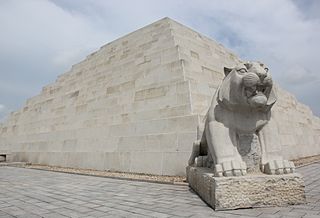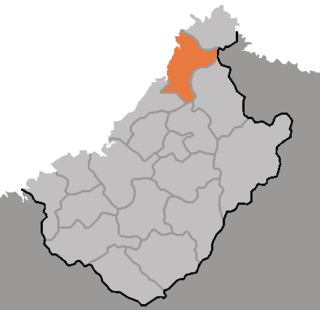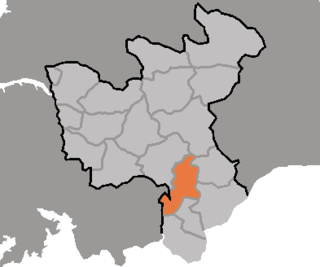
The Mausoleum of Tangun is an ancient burial site in Kangdong near Pyongyang, North Korea. It is claimed by North Korea to be the tomb of Tangun, legendary founder of Gojoseon, the first Korean kingdom.

The M-1978 Koksan is a 170 mm self-propelled gun of North Korean design and manufacture. Very little information is available due to the secretive nature of the North Korean government. The designations M-1978 and Koksan were given to the type by US military analysts, as they first became aware of it in that year in Koksan, North Korea.

Chasŏng County is a county (kun) in Chagang Province, North Korea. The city is immediately south of the Chinese-North Korean border. Its approximate population to 7 km from the city center is 8,317. The average altitude is 1279 feet, or 389 meters. Nearby cities and towns include Haengjangp'yong and Umnae-dong.

Ch'ŏrwŏn County is a kun, or county, in Kangwŏn province, North Korea. Portions of it were once a single county together with the county of the same name in South Korea; other portions were added from neighbouring counties in the 1952 reorganization of local governments. After the initial division of Korea, the entire county lay to the Northern side of the dividing line, but in the course of the Korean War part of the county was taken by the South.
Ryŏhyŏn station is a railway station located in Ryŏhyŏl-li, Kaep'ung County, North Hwanghae province, North Korea. It is located on the P'yŏngbu Line, which was formed from part of the Kyŏngŭi Line to accommodate the shift of the capital from Seoul to P'yŏngyang. Though this line physically connects P'yŏngyang to Pusan via Dorasan, in operational reality it ends at Kaesŏng due to the Korean Demilitarized Zone.
Kyejŏng station is a railway station located in Kyejŏng-ri, Kŭmch'ŏn County, North Hwanghae province, North Korea. It is on located on the P'yŏngbu Line, which was formed from part of the Kyŏngŭi Line to accommodate the shift of the capital from Seoul to P'yŏngyang; though this line physically connects P'yŏngyang to Pusan via Dorasan, in operational reality it ends at Kaesŏng due to the Korean Demilitarized Zone.
Hanp'o station is a railway station located in Hanp'o-ri, P'yŏngsan County, North Hwanghae province, North Korea. It is on located on the P'yŏngbu Line, which was formed from part of the Kyŏngŭi Line to accommodate the shift of the capital from Seoul to P'yŏngyang; though this line physically connects P'yŏngyang to Pusan via Dorasan, in operational reality it ends at Kaesŏng due to the Korean Demilitarized Zone.
Taebaeksansŏng station is a railway station in Sansŏng-ri, P‘yŏngsan County, North Hwanghae province, North Korea. It is on the P'yŏngbu Line, which was formed from part of the Kyŏngŭi Line to accommodate the shift of the capital from Seoul to P'yŏngyang. Though this line physically connects P'yŏngyang to Pusan via Dorasan, in operational reality it ends at Kaesŏng due to the Korean Demilitarized Zone.
Mulgae station is a railway station located in P‘yŏngsan County, North Hwanghae province, North Korea. It is on located on the P'yŏngbu Line, which was formed from part of the Kyŏngŭi Line to accommodate the shift of the capital from Seoul to P'yŏngyang; though this line physically connects P'yŏngyang to Pusan via Dorasan, in operational reality it ends at Kaesŏng due to the Korean Demilitarized Zone.
Munmu station is a railway station located in Munmu-ri, Sŏhŭng County, North Hwanghae province, North Korea. It is on located on the P'yŏngbu Line, which was formed from part of the Kyŏngŭi Line to accommodate the shift of the capital from Seoul to P'yŏngyang; though this line physically connects P'yŏngyang to Pusan via Dorasan, in operational reality it ends at Kaesŏng due to the Korean Demilitarized Zone.
Hŭngsu station is a railway station located in Hŭngsu-ri, Pongsan County, North Hwanghae province, North Korea. It is on located on the P'yŏngbu Line, which was formed from part of the Kyŏngŭi Line to accommodate the shift of the capital from Seoul to P'yŏngyang; though this line physically connects P'yŏngyang to Pusan via Dorasan, in operational reality it ends at Kaesŏng due to the Korean Demilitarized Zone.

Kŭmch'ŏn County is a county in the North Hwanghae province of North Korea. It has a population of 68,216.
Koksan Airport is an airport near Koksan, Hwanghae-bukto, North Korea.
Pyongsul Li Airport is an airport near Tŏkhŭng-ni in Koksan, Hwanghae-bukto, North Korea. Pyŏngsul-li village was named after Tŏkhŭng-ni in 1982.

The Royal Tombs of the Koryo Dynasty are a group of tombs of members of the Korean Koryo Dynasty (918-1392).

Hoech'ang County is a kun (county) in South P'yŏngan province, North Korea.

Sŏhŭng County is a county in North Hwanghae province, North Korea.

The geology of North Korea has been studied by the Central Geological Survey of Mineral Resources, rare international research and by inference from South Korea's geology.










